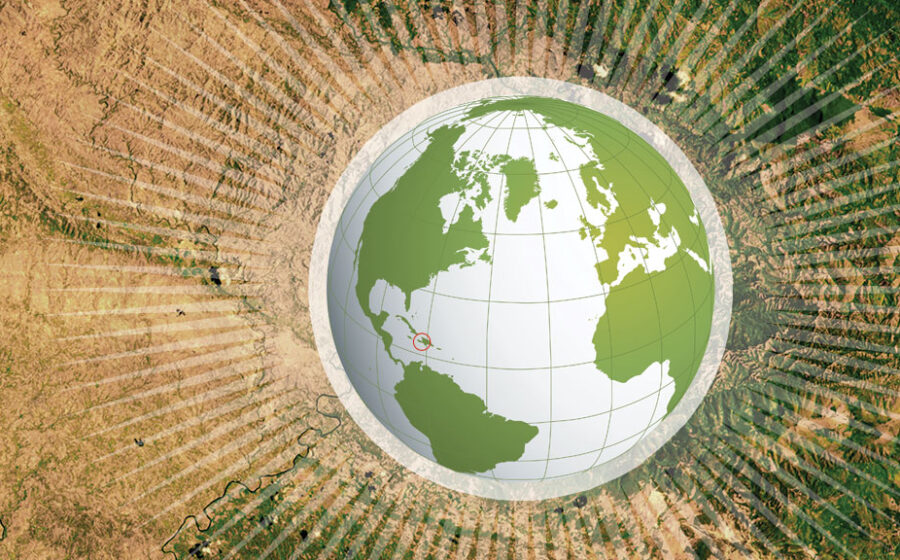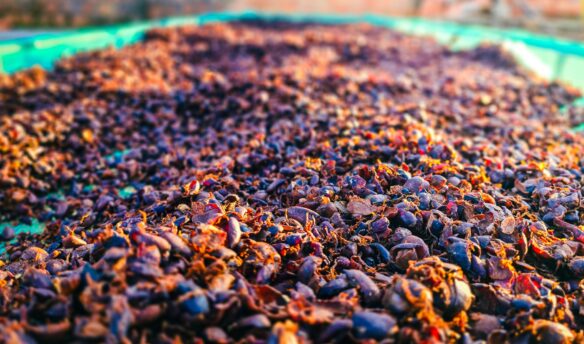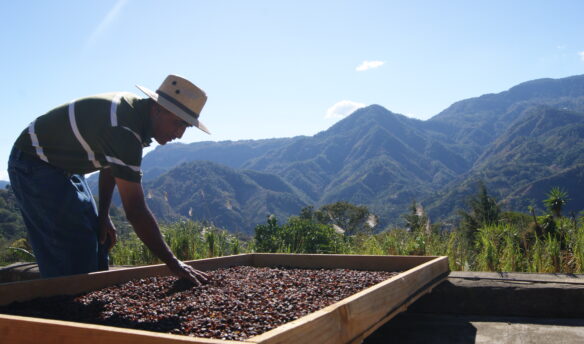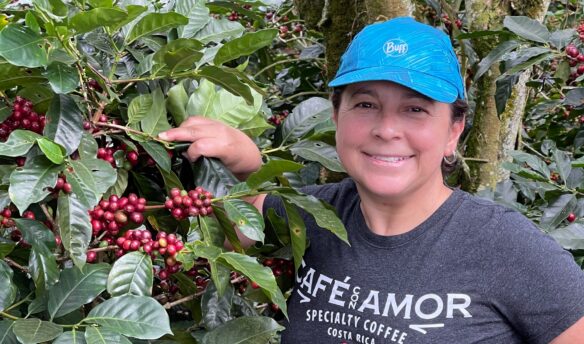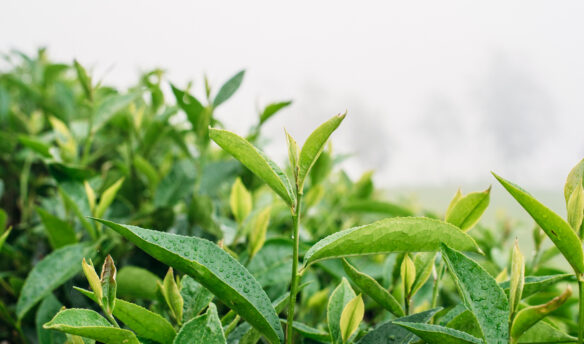[M]y grandparents couldn’t have fathomed paying five dollars for a cup of coffee. For that price, they could buy an entire vacuum-sealed can of the Maxwell House or Folgers grounds that lined the pantries of their generation.
In the last several decades, coffee consumption has transformed dramatically; the retail coffee market in the United States is estimated to be worth nearly $50 billion. The specialty segment has been booming as well, growing at an estimated 10 percent annually for about a decade.
Continued growth in the specialty market presents new opportunities for coffee producers. By selling to a quality-minded buyer, a coffee grower might be paid twice what he or she would make if selling into a less-discriminating commodity market. Amidst this boom, however, there’s an overarching challenge staring down coffee farmers: climate change.
Opportunities in high-end coffee
Coffee is a finicky plant—especially Coffea arabica, the species known for its excellent cup quality. Coffee trees grow only in specific microclimates limited to wet, mountainous areas of the globe’s tropical belt. As temperatures are predicted to rise in coming decades, the area viable for coffee cultivation is expected to retreat toward cooler climes found at higher elevations.
The latest research from both the International Center for Tropical Agriculture and World Coffee Research suggests that by 2050, the global area suitable for coffee production could shrink by half. Farmers who currently rely on coffee for their livelihoods could be devastated—if they don’t find ways to adapt to their changing environment.
Because most coffee is harvested selectively by hand, and coffee cherries ripen sporadically over the course of a months-long season, there are relatively few economies of scale in harvesting it. Partly for this reason, coffee is one of the most profitable crops for small-scale farmers. Collectively, an estimated 25 million smallholder farmers produce about 80 percent of the world’s coffee. And because they’ll never compete with the volume produced by high-yield farms, the more lucrative specialty market is a natural fit. Even a meager harvest can be a worthwhile proposition if sold at the right price.
The high-end coffee boom has encouraged more product differentiation. Roasters often market a bag of coffee similar to wine—labels might feature information about the variety of the coffee plant, the altitude at which it grew, and how the beans were processed, all of which can influence its taste. Roasters are also likely to emphasize the coffee’s origin down to the growing country, region, and even farm.
As one result, producers have become the focal points of specialty coffee marketing. A trend toward direct-trade and relationship-focused coffee sourcing has further highlighted the role of producers. Consequently, awareness has shifted toward the challenges at this end of the supply chain—including climate change, and how it might shift the outlook of the global industry over coming generations. If there’s one coffee-growing country that may be an indicator of what’s to come for the global industry, it’s Haiti.
Haiti as a harbinger
“It’s better to grow something you can sell on the international market,” says Dieujuste Joseph, a farmer in the mountains of southeastern Haiti. As we walk around his farm, Joseph explains that he can make more money selling his high-quality arabica coffee into an export market than by selling to local buyers. But diversifying his crop production is also important to him, he adds. Avocado, mango, banana, and grapefruit trees also grow among his coffee plants.
Coffee, in theory, is a great option for a rural farmer in tropical mountains. But many of Joseph’s fellow Haitian farmers have either neglected their coffee or abandoned it entirely because they’re “in misery,” he says, struggling to feed their families. Their need for subsistence crops to feed a family today wins out over investing in a longer-term cash crop.
Haiti’s coffee sector has been on a steady decline for a half-century. Since the 1980s, production has fallen by half, and official exports have plummeted by 95 percent. There are many underlying causes—some of them not related to coffee at all. Since Haiti gained its independence through a successful slave revolution in 1804, it has been plagued by political instability and weak institutions. Regardless of leader, the state has too often focused on private, short-term gain rather than building a proper education system, functioning roads, a fair judiciary, or any other system that would help its citizens flourish.
The uncertainty that still undergirds much of daily life threatens long-term planning and investment of all sorts. Coffee plants can take up to four years for a new seedling to give its first full harvest. Food crops like beans or vegetables, on the other hand, have multiple growing cycles each year, and can help feed a farmer’s family in addition to earning income on local markets.
Beyond the economic challenges, coffee plants are vulnerable to more than 1,000 diseases and pests, including two of the most damaging—coffee leaf rust and the berry borer beetle.
When it comes to weathering natural hazards like hurricanes, drought, and earthquakes, Haiti is one of the least-resilient nations in the world. While some of its vulnerability can be chalked up to unfortunate geography—the country lies along a hurricane alley and sits on a tectonic boundary—most experts agree that the crux of it is poverty, along with the consequent deforestation and soil erosion after centuries of pressure on the land. For many of the same reasons that Haiti is vulnerable to natural disasters, a changing climate stands to exacerbate many of the coffee sector’s existing challenges—if not decimate the industry entirely.
Coping with change
Most experts agree that climate change is expected to weaken coffee-growing prospects in much of Haiti. A 2014 report by the International Center for Tropical Agriculture (CIAT) notes that by 2050 “coffee will become considerably less suitable for production at lower elevations.” Less rainfall and higher temperatures could cause both coffee yields and quality to fall, especially at altitudes below 1,200 meters.
Varying climate conditions increase coffee’s susceptibility to pests and disease. Too much moisture can promote leaf rust, where orangish spores attack leaves and prevent plants from photosynthesizing, capable of destroying an entire farm in a single season. (In 2012, a rust epidemic caused an estimated $1 billion in crop losses across Central America.) Too little rain, on the other hand, will stress the plants’ ability to produce full crops. Drier conditions can also be favorable to certain types of borer beetles that attack coffee.
The CIAT models predict that while arabica coffee production will become less viable in low-altitude areas, it will become more suitable in higher areas, including the southeastern mountains where Joseph lives and farms.
Most Haitian farmers practice diversified agriculture. But farmers at low elevations will likely have to diversify into other crops further in the face of climate change, if not completely replace their coffee production. Cacao may be one viable alternative—CIAT notes that it’s “highly suitable for production in Haiti and is likely to remain so, despite long-term changes in the climate.” Like coffee, cacao also grows in tropical mountains, just at lower altitudes.
Impending climate challenges will require various solutions depending on context and local factors, but the CIAT report makes one recommendation clear: farmers should adapt.
Moving forward
Potential adaptations to manage these effects include irrigation systems, improved coffee varieties resistant to drought or disease, and better shade management to cope with higher temperatures. Haitian growers may be well-suited to improve shade conditions. Most of their coffee is already grown under some shade, largely due to the diversified agriculture practiced throughout the country. A major question for Haiti, however, will be how small-scale farmers can accomplish these sorts of adaptations in a country with a per capita gross domestic product of just $830 (compared to approximately $55,000 in the United States) and feeble political and legal institutions that are antithetical to long-term investment.
It may simply turn out that it will no longer make sense for many Haitian coffee farmers to remain coffee farmers. Mangoes, cacao, and other crops, if not other lines of work entirely, may become better options given the trade-offs. But if adaptation will be particularly difficult for Haiti, other countries should be better suited to adapt to a new coffee world.
Cenicafé, Colombia’s national coffee research center, for instance, has spent decades investing in developing coffee varieties resistant to leaf rust. The center has helped Colombian farmers replace more than three billion coffee trees with improved varieties, translating into “higher productivity and regional adaptation.” Thanks to a Cenicafé web platform, Colombian growers can also check regional climate conditions online and compare them to historical trends.
Similarly, Brazil has funded research for coffee adaptation strategies using heat-resistant varieties suitable for the relatively low altitudes and high temperatures of the country’s coffee areas. Certain growers in Guatemala have also begun to adapt their farms by using improved shade management, homemade sprays that help prevent leaf rust, and mixes of both traditional and disease-resistant or high-yielding varieties. Some have even started to diversify their coffee production with cardamom and honey.
Most coffee agronomy research is conducted by public institutions or national governments. As the coffee sector’s vulnerability to climate has become more apparent in recent years, however, the private sector has started to focus on the great needs at the production end of the chain—and on what will have to happen to make sure the sector will be able to adapt and continue to thrive.
World Coffee Research (WCR), a nonprofit organization housed at Texas A&M University and largely funded by donations from coffee importers, roasters, and industry stakeholders, is pushing the limits of coffee research—“ensuring the future of coffee,” as its website reads. In the summer of 2016, WCR released Coffee Varieties of Mesoamerica and the Caribbean, a comprehensive variety catalog packed with information concerning yields, disease resistance, botanical data, and cup quality for coffee varieties grown across Central America and the Caribbean. The organization estimates that just by using the resource to help make decisions about which varieties to plant, farmers can increase both coffee quality and quantity by up to 15 percent.
Bullish on the bean
Enthusiasm for pour-over, espresso, and other higher-priced coffee drinks shows no sign of slowing any time soon—which bodes well for the next generation of coffee farmers. It’s a good bet this demand will continue to drive innovation and adaptation, ensuring coffee drinkers around the globe can still get their fix.
Adaptations and solutions to changing climates will likely look very different from Brazil to Ethiopia to Haiti. Despite doomsday headlines about “coffee’s coming extinction” due to climate change, global demand will continue to drive innovations from the coffee farmers, agronomists, and researchers who make the sector their lives and livelihoods—and ensure pour-over and espresso remain. From farmers’ perspectives, the world of coffee production may look very different in the next fifty years—and it’s possible many will not call themselves coffee growers anymore.
—Tate Watkins is an economic journalist and research and publications fellow at the Property and Environment Research Center (PERC).



